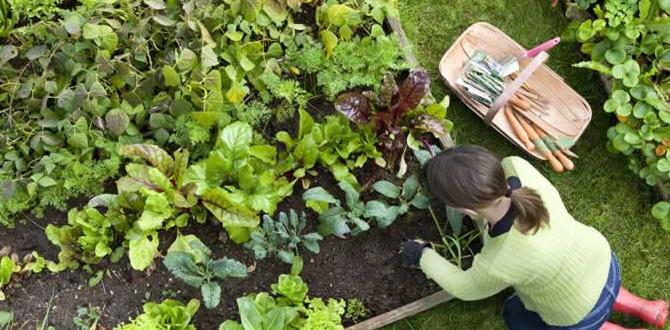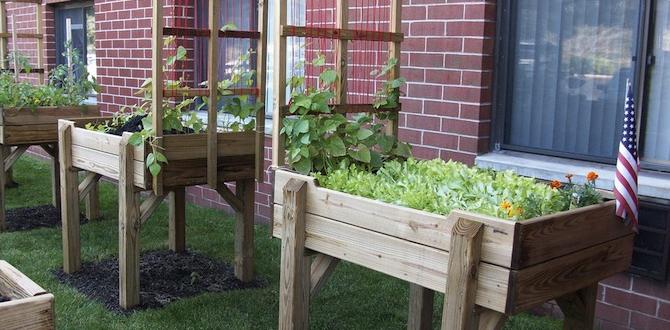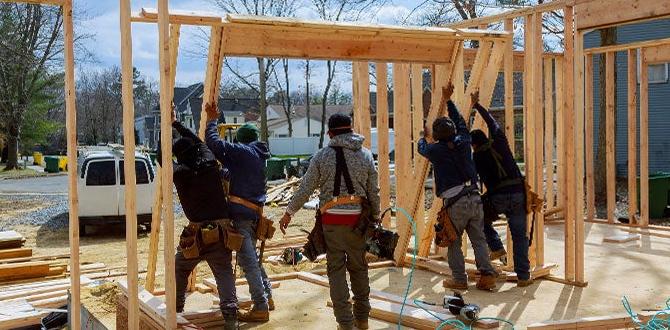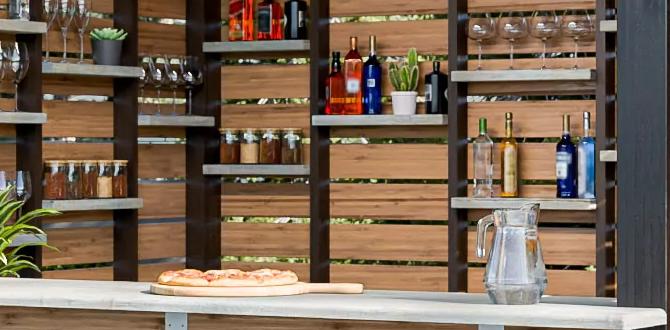Have you ever thought about how much joy gardening can bring? For many, it’s a relaxing escape into nature. But what if you have a disability? Can you still enjoy the beauty of gardening? The answer is yes! Gardening for the handicapped is not just possible; it can be a rewarding experience.
Imagine designing your own garden, right outside your door. You can grow colorful flowers or tasty veggies. Even using a wheelchair doesn’t mean you can’t garden. Many tools and techniques make it easier and more fun. Did you know that raised garden beds allow easy access for everyone?
In this article, we will explore how gardening can be adapted for those with disabilities. We’ll share practical tips and inspiring stories. You don’t need to be an expert gardener to start. Just a little creativity and a garden space can make all the difference!
Gardening For Handicapped: Accessible Tips And Techniques

Gardening for Handicapped
Gardening can be a joyful activity for everyone, including those with disabilities. Accessible tools and raised beds make planting possible. Did you know that adaptive equipment can reduce strain? Many gardens create a peaceful escape. Visualizing flowers blooming might inspire anyone, regardless of ability. By using vertical gardening methods, space becomes less of a barrier. It’s all about enjoying nature and feeling accomplished. Gardening truly promotes wellness and creativity for all!Understanding the Benefits of Gardening for Handicapped Individuals
Emotional and psychological benefits. Physical health improvements and therapeutic effects.
Gardening can bring many great benefits to individuals with disabilities. It helps them feel happier and more calm. Connecting with nature lifts their spirits. Physical activity through gardening can make muscles stronger and improve balance. This can help with mobility and daily tasks. It can even reduce stress and anxiety.
- Emotional Benefits: Gardening provides a sense of accomplishment.
- Psychological Benefits: It boosts mood and reduces feelings of isolation.
- Physical Health Improvements: Gardening helps with strength and flexibility.
- Therapeutic Effects: Nature therapy can lower blood pressure and improve mental health.
How does gardening help mental health?
Gardening helps mental health by providing relaxation and joy. Spending time outdoors can make a person feel more connected and less alone. The joy of planting and watching things grow brings happiness.
Choosing the Right Gardening Techniques
Raised bed gardening options. Container gardening for mobility limitations.
Picking the right gardening methods can make a world of difference. For those who need a little extra help, raised bed gardening is like having a planting buddy—no bending needed! These beds are higher off the ground, making it easier to reach your plants without turning into a pretzel. On the other hand, container gardening lets you have your flowers or veggies right at your fingertips. You can move pots anywhere, from a sunny spot on the patio to a shady nook in the garden. Let’s take a fun look:
| Option | Benefits |
|---|---|
| Raised Beds | Less bending, easier access |
| Container Gardening | Mobility-friendly, movable |
With these choices, gardening becomes a piece of cake, or perhaps a piece of carrot cake! So grab your gloves and let’s dig in!
Essential Tools for Accessible Gardening
Ergonomic gardening tools and their benefits. Adaptive tools for enhanced usability.
Gardening can be fun and rewarding, even for people with limited mobility. Using ergonomic tools helps reduce strain on the body. These tools are shaped to fit comfortably in your hands. They make digging and planting easier. Similarly, adaptive tools can be adjusted for better use. For example, long-handled garden tools let you work while standing. This saves energy and keeps you comfortable.
- Lightweight materials for easy handling
- Handles designed to minimize grip effort
- Extension claws for reaching hard spots
With the right tools, anyone can enjoy gardening!
What are ergonomic gardening tools?
Ergonomic gardening tools are specially designed to fit better in a person’s hand and reduce strain. They help users garden longer with less discomfort.
Designing an Accessible Garden Space
Layout considerations for wheelchair accessibility. Pathway materials and garden edging solutions.
Making a garden easy to use is important for everyone. For wheelchair users, paths must be wide and smooth. Use materials like bricks or gravel that won’t get muddy. Here are some layout tips:
- Keep pathways at least 36 inches wide.
- Avoid steep slopes; keep surfaces flat.
- Use raised beds for easy planting and care.
Choose edging that won’t be a barrier, like soft materials. A well-designed garden helps everyone enjoy nature.
What materials are best for wheelchair garden paths?
Best materials include bricks, concrete, and woven mulch. They allow easy movement and are comfortable to navigate.
Plant Selection for Ease of Care
Lowmaintenance plant varieties. Edible plants suitable for container gardening.
Choosing the right plants makes gardening easier. Low-maintenance options are perfect for hobbists. Think about these simple plants:
- Succulents: They need little water and thrive in sunny spots.
- Herbs: Basil and mint grow easily in pots.
- Cherry Tomatoes: These tasty fruits grow well in containers.
Edible plants in containers can be fun. You’ll enjoy your harvest while keeping things manageable. Plus, gardening at home is rewarding!
What are easy plants for container gardening?
Some easy plants for container gardening include herbs, succulents, and cherry tomatoes. They require less care and are ideal for smaller spaces.
Incorporating Technology in Gardening
App and gadget recommendations for assistance. Automated gardening systems for reduced physical strain.
Gardening can be tricky, but tech is here to lend a hand—literally! There are amazing apps and gadgets that help make gardening easier. For example, smart watering systems keep plants happy without any heavy lifting. Automated garden tools let you sit back while they do the work. It’s like having a robot gardener! Below is a quick look at some cool tools that can help:
| Tool/App | Purpose |
|---|---|
| Garden Manager App | Tracks plant care schedules |
| Smart Irrigation Systems | Water plants automatically |
| Ergonomic Tools | Reduce strain on hands and back |
With these tools, you can enjoy the magic of gardening without the hassle. Who knew plants could be such great roommates?
Community Resources and Support Groups
Local organizations focused on gardening initiatives. Online forums and networks for sharing experiences.
Did you know many local organizations love to help with gardening? They focus on making gardening fun and accessible for everyone. Checking out local clubs can be a blast! You can make friends while digging in the dirt. Online forums are also great for sharing stories and tips. You’ll find people with similar experiences, and they might even share a few plant puns!
| Resource Type | Description |
|---|---|
| Local Organizations | Groups that support gardening projects for all abilities. |
| Online Forums | Platforms to share gardening tips and funny stories. |
Gardening Adaptations for Different Disabilities
Strategies for individuals with limited arm strength. Solutions for visual impairments in gardening activities.
Gardening can be a joy for everyone, even with some challenges! For those with limited arm strength, using raised beds can make planting easy. Long-handled tools help reach those tricky spots. For friends with visual impairments, colorful plant labels and textured gardening gloves can guide their hands. Sometimes, a trusty friend or trusty dog can help! Remember, gardening is about having fun, and you never know when you might discover a hidden treasure in the dirt!
| Disability | Adaptation |
|---|---|
| Limited Arm Strength | Raised Beds, Long-Handled Tools |
| Visual Impairments | Colorful Labels, Textured Gloves |
Success Stories: Inspiring Examples of Handicapped Gardeners
Profiles of individuals achieving gardening success. Impact of gardening on their quality of life.
Many brave individuals have found joy through gardening, even with challenges. For example, a woman named Sarah, who uses a wheelchair, created a beautiful raised garden bed. She grows tomatoes and herbs. Gardening helps her feel happier and healthier.
Another inspiring story is of Tom, who has limited mobility. He uses adaptive tools to grow vegetables in his backyard. Thanks to this hobby, he feels more independent and connected to nature.
- Improved happiness and mood
- Increased physical activity
- Greater sense of community
These stories show the amazing benefits of gardening for those facing challenges. With creativity and determination, anyone can enjoy the garden in their own way.
How does gardening help people with disabilities?
Gardening improves mental health, provides physical activities, and fosters independence. It encourages creativity and connection to nature, making life brighter for those who face challenges.
Conclusion
In summary, gardening for the handicapped helps you enjoy nature and grow plants easily. You can use raised beds, adaptive tools, and container gardens. These options make gardening fun and accessible. Try starting a small garden project or reading more about accessible gardening techniques. You’ll find that nurturing plants can boost your mood and creativity!FAQs
What Are Some Adaptive Gardening Tools Designed Specifically For Individuals With Limited Mobility?There are special gardening tools that help people with limited movement. One tool is a long-handled rake or hoe. This lets you reach plants without bending over. There are also graspable handles that make it easier to hold tools. Raised garden beds can help too, so you don’t need to kneel. These tools make gardening fun and easy!
How Can Raised Garden Beds Benefit Gardeners With Disabilities, And What Are The Best Heights For Accessibility?Raised garden beds can really help gardeners with disabilities. They lift the plants up, so you don’t have to bend down as much. This makes it easier for you to take care of your plants. A good height for raised beds is between 24 to 36 inches. This way, you can sit or stand comfortably while you work.
What Types Of Plants Are Low-Maintenance And Suitable For Gardeners Who May Face Physical Challenges?If you want easy plants to care for, try succulents, like aloe or jade plants. They don’t need much water. You can also grow herbs like basil and mint in small pots. Consider using raised garden beds, so you don’t have to bend down too much. These plants make gardening fun and simple!
How Can Sensory Gardens Enhance The Gardening Experience For Individuals With Visual Or Cognitive Impairments?Sensory gardens are special gardens that help people enjoy nature in different ways. They have bright colors, fun shapes, and soft plants to touch. You can also find plants that smell nice and make sounds when the wind blows. These gardens let you use your other senses, making gardening exciting for everyone, even if you can’t see well or find it hard to think clearly. We can feel more relaxed and happy in a sensory garden!
What Techniques Can Be Employed To Make Gardening More Accessible For Individuals Who Use Wheelchairs Or Other Mobility Aids?We can make gardening easier for people in wheelchairs by using raised garden beds. These beds are higher off the ground, so you can reach them without bending over. We can also keep paths wide enough for wheelchairs. Using tools with long handles helps too, because you don’t need to lean as much. Finally, adding comfy seating can help you take breaks when you need to.
{“@context”:”https://schema.org”,”@type”: “FAQPage”,”mainEntity”:[{“@type”: “Question”,”name”: “What Are Some Adaptive Gardening Tools Designed Specifically For Individuals With Limited Mobility? “,”acceptedAnswer”: {“@type”: “Answer”,”text”: “There are special gardening tools that help people with limited movement. One tool is a long-handled rake or hoe. This lets you reach plants without bending over. There are also graspable handles that make it easier to hold tools. Raised garden beds can help too, so you don’t need to kneel. These tools make gardening fun and easy!”}},{“@type”: “Question”,”name”: “How Can Raised Garden Beds Benefit Gardeners With Disabilities, And What Are The Best Heights For Accessibility? “,”acceptedAnswer”: {“@type”: “Answer”,”text”: “Raised garden beds can really help gardeners with disabilities. They lift the plants up, so you don’t have to bend down as much. This makes it easier for you to take care of your plants. A good height for raised beds is between 24 to 36 inches. This way, you can sit or stand comfortably while you work.”}},{“@type”: “Question”,”name”: “What Types Of Plants Are Low-Maintenance And Suitable For Gardeners Who May Face Physical Challenges? “,”acceptedAnswer”: {“@type”: “Answer”,”text”: “If you want easy plants to care for, try succulents, like aloe or jade plants. They don’t need much water. You can also grow herbs like basil and mint in small pots. Consider using raised garden beds, so you don’t have to bend down too much. These plants make gardening fun and simple!”}},{“@type”: “Question”,”name”: “How Can Sensory Gardens Enhance The Gardening Experience For Individuals With Visual Or Cognitive Impairments? “,”acceptedAnswer”: {“@type”: “Answer”,”text”: “Sensory gardens are special gardens that help people enjoy nature in different ways. They have bright colors, fun shapes, and soft plants to touch. You can also find plants that smell nice and make sounds when the wind blows. These gardens let you use your other senses, making gardening exciting for everyone, even if you can’t see well or find it hard to think clearly. We can feel more relaxed and happy in a sensory garden!”}},{“@type”: “Question”,”name”: “What Techniques Can Be Employed To Make Gardening More Accessible For Individuals Who Use Wheelchairs Or Other Mobility Aids? “,”acceptedAnswer”: {“@type”: “Answer”,”text”: “We can make gardening easier for people in wheelchairs by using raised garden beds. These beds are higher off the ground, so you can reach them without bending over. We can also keep paths wide enough for wheelchairs. Using tools with long handles helps too, because you don’t need to lean as much. Finally, adding comfy seating can help you take breaks when you need to.”}}]}




